From Nukus, Uzbekistan to Samarkand, Uzbekistan June 14th – July 6th 2018
Our guide book had told us that Nukus had “a general sense of hopelessness and desolation” so our expectations were not high. Imagine our surprise then, when we found we really liked it. After the desert and our long and tiring train ride it was like an oasis with wide tree lined avenues, admittedly rather square ex Soviet buildings but they were all white and bright and clean, lots of greenery and flower beds, a very vibrant and colourful bazaar and Pete says the best coffee shop since Hallbankgate Hub. Nukus’ main claim to fame is an amazing museum that houses one of the best and largest collections of Soviet art in the world.

So lots going on in Nukus and it was with some reluctance that we once again headed out of town and back into the beige brown of the desert. We were now heading for the three most iconic silk road towns, Khiva, Bukhara and Samarkand. Even just saying their names brought a tingle of excitement. We were really here following all those camel trains and probably not going much faster but still seeing what they saw which at this point was endless, flat, scrubby desert with little to differentiate one mile from the next. That is until we saw an abandoned aeroplane on the horizon. How did that get there? Possibly a question that may never be answered.

For the first 60 kms or so we had the road to ourselves and it was smooth and beautiful. Inexplicably this was a brand new road, parallel to the old road but not being used. A bike can get where a car cannot so we pushed ourselves onto this piece of heaven looking across at the cars bumping and weaving along the old road and feeling very lucky.

All good things come to an end and it was time to turn off to Khiva and a dramatic change in landscape. We were now heading towards the Amu Darya river, a huge expanse of water that we crossed on a rather eccentric pontoon bridge seemingly held together with metal plates which would have been impossibly slippery in the wet. The bridge was guarded by soldiers on both banks who officiously forbade me from taking any photographs. This photograph was taken by Marita who has kindly let me use it.

The river has been heavily used for irrigation and for supplying the water hungry cotton industry introduced by the Soviets in the 50’s making Uzbekistan the 5th largest producer of cotton in the world. This huge demand for water has contributed significantly to what has been described as one of the worlds largest environmental disasters in recent history where the river no longer reaches the Aral Sea but disappears into the desert. Consequently the sea has decreased in size by 50% since 1960. This has created salt deserts and climatic change so that fishing boats lie stranded in the desert and have become a macabre tourist attraction. This has had a massive impact on the livelihoods of the people living there where there was once a thriving fishing industry there is now poisoned land and the water that remains is so salty that you could float a brick in it. All terribly sad and it was with mixed feelings that we now entered a lush, well irrigated area with crops, and fruit trees and a well organised system of canals. It was all so green and like entering a different world but at what a cost.


That night we slept in a football stadium and were woken at 5 am by joggers circling the track who seemed not in the least perturbed by a tent suddenly springing up in their midst.

We were finding the people here incredibly friendly and already we were getting a lot of attention and many requests for “selfies”. Instant friendships made and probably as quickly forgotten but certainly leaving behind a feeling of being very welcome in what for us was a very different culture and environment from what we had so far experienced.
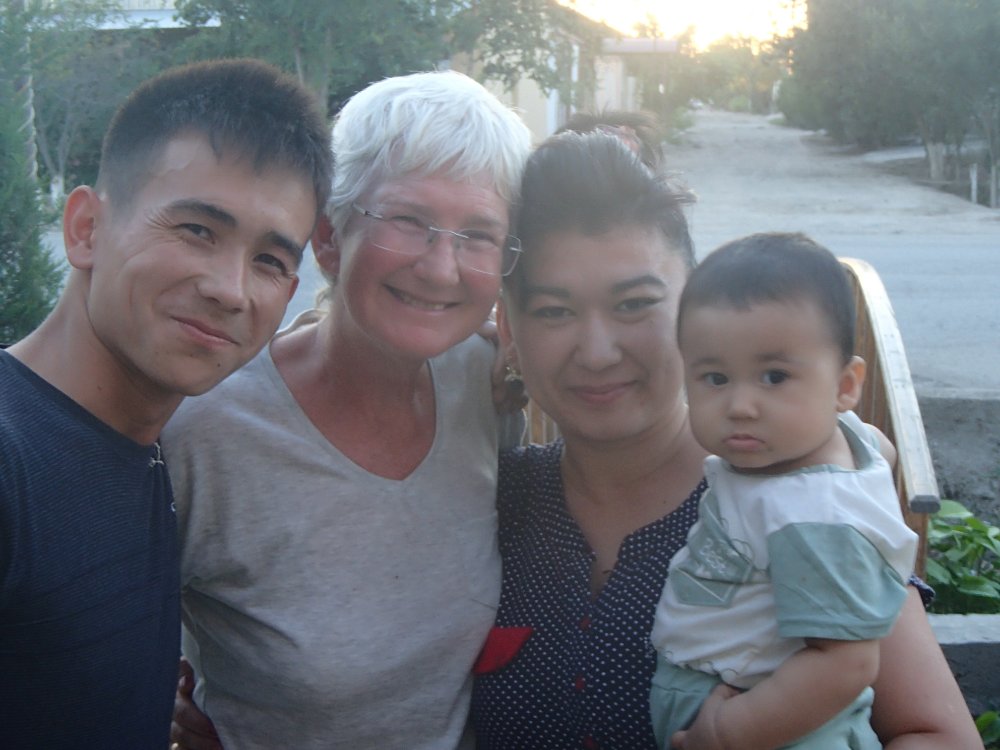
Memories of our beautiful road were now very distant and we were now choking on dust and fumes and feeling that our teeth might fall out at any minute.

Avoiding pot holes became an art and it was getting hotter and so It was a great relief to enter Khiva.
Khiva was like something from the Arabian nights with its old town walls that looked like an overgrown sandcastle.
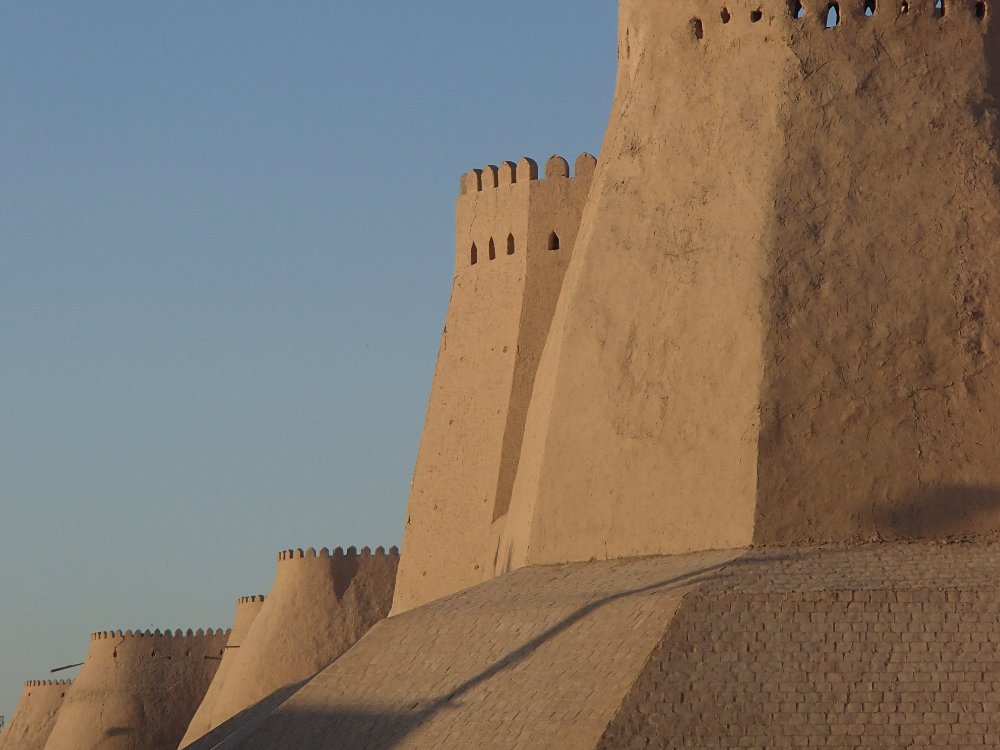
It has a cruel history of being a centre for the slave trade and it isn’t hard to imagine noisy markets and human suffering in what sometimes looked like a film set. The Tourist Police manned the main gated entrance to the old town and despite their friendly smiles one had the feeling that you needed to behave yourself.
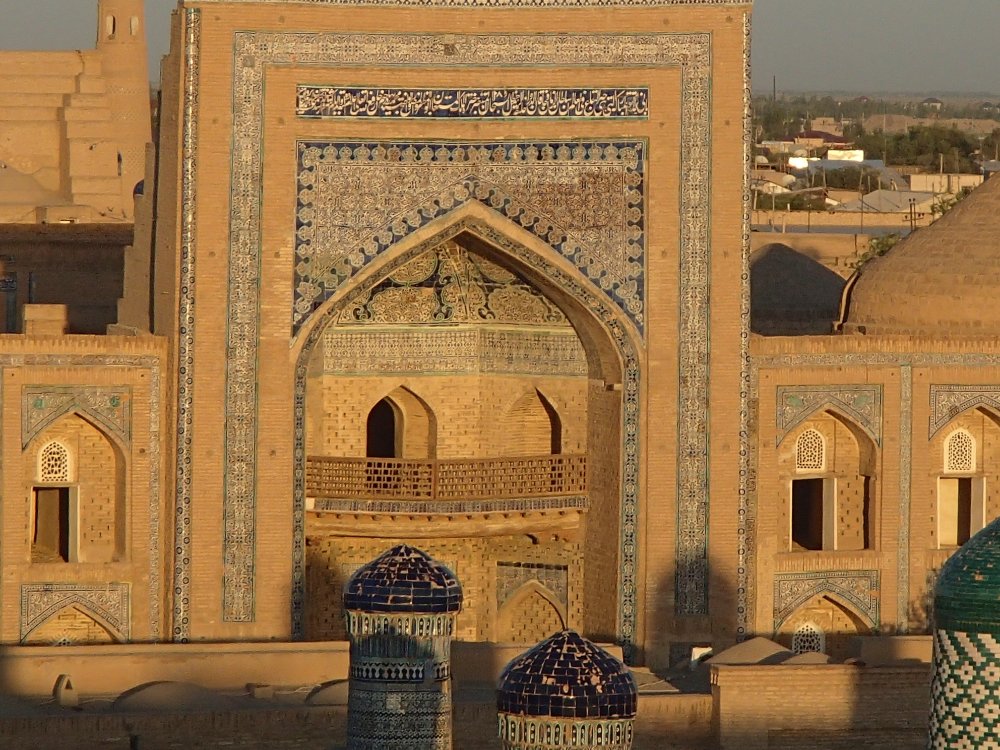
The town is full of minarets, medrasses, enticing alleyways and crumbly mud houses. Despite it being a UNESCO sight this is very much a living, breathing town and our favourite time to explore was in the early evening when the children were all out playing football and cycling and the sun was turning the stone walls to a rich golden yellow. The most striking of all the buildings for me was the Kalta Minor minaret ordered to be built by Muhammad Amin Khan who wanted it to be so big that it could be seen from Bukhara 450 kms away. At 29m high it only reached a third of its projected height as the Khan died and building was stopped. It reminded me of a huge, glazed biscuit barrel.


After 4 days in Khiva we were ready to move on. The temperature was rising and we knew that we would be cycling in the highest temperatures we had experienced so far. We had 460 km of desert to cross to get to Bukhara and it was daunting. We decided we needed a strategy. The plan was that we would set off as early as we could each morning. We would stop every 10 kms to drink copious amounts of water. We would stop at each available tea house to cool down and we would have a long afternoon siesta in a tea house from about 1 until 5pm. We would then cycle till dusk. We pretty much stuck to this and woke at 5 and were always on the road by 6. This gave us at least 2 hours of cool(ish) cycling. From then on we were a sweaty mess but managed to keep going until siesta time.

The tea houses varied a lot. Some were little more than a tin shack, others large and palatial but they all had tapchans which are like a large bed, usually with a table in the centre. Some people recline while they eat, others sit cross legged at the table. Most people once they have finished eating will lie down and have a sleep. How civilised! So it was quite acceptable for us to curl up on a tapchan every afternoon and doze the hours away. I remember one tea house that had a lot of tapchans with bodies sprawled on each one and feeling as if I was in a hospital ward expecting to have my temperature checked any minute.

The camaraderie of the road kicked in at this point and Marita and Roberto who were a couple of days ahead of us constantly messaged with useful information. “After milepost 231 there is a tea house -the last one for 30 km.” ” The tea house at milepost 310 does a great soup”. We were on the look out for one particular tea house they had mentioned and thought we had found it and rolled up to it. The owner looked surprised to see us but by now we were used to this reaction and thought nothing of it. When we asked for food he opened the fridge door and there wasn’t much in it other than some eggs so we asked if we could have some bread and fried eggs. After we had eaten he said that we could use the shower around the back and this was the most wonderful gift that he could have offered us. The shower was in a rusty metal cubicle with a pipe spouting very cold water and was probably the best shower I have ever had in my life.

After that we did some washing and draped it around his satellite dish and then settled In for a 2 hour snooze. It was only as we were packing up to go that we realised no one else had used the tea house all afternoon. It was only as we cycled down the road and soon came across a very obvious tea house that we wondered if we had been in someone’s home all afternoon. Whoops.

As we travel along this amazing road we have time to ponder the history and marvel at how things have changed. The camel trains would often have as many as 150 camels. Feeding and watering and maintaining these huge groups must have been challenging but where we had the tea houses they had the caravanserrai. Where they were carrying spices, tea and silk, today’s container lorries are carrying lots of stuff that probably contains a lot of plastic.


What I do envy the camel trains was how much quieter it must have been. The soundscape to our lives now is the constant roar of traffic and the hooting of horns, usually in greeting and encouragement but sometimes in anger and a wish for us to get out of the way -quickly. We usually start off the day responding politely to all these greetings, trying to rationalise that for that person it is the first time they may have seen a tourist on a bike and they want to say hello. We take our hands off the handlebars to wave and then smile which is fine for a while but as the day wears on and we become hotter and more tired it gets hard and sometimes a nod has to suffice. After the 159th hoot that day I want to put my head down and ignore them but then I think my karma will be upset and that person may then go away thinking all foreign tourists are rude and ignorant and they might not be as nice to the next one. The worst scenario is the mobile interview which usually happens to Pete. A car comes alongside when he is trying very hard to concentrate on avoiding potholes and cars or bicycles going the wrongway, usually towards him at speed, pedestrians wandering out in front of him and often other people shouting and hello-ing from the other side of the road. It is hot, dusty, noisy.The window is wound down , the smart phone is out and videoing the scene, questions are asked. What is your name? Where are you from ? How old are you? Where are you going? I’m always amazed at how calm and polite he is.

Squeamishness Alert. Do not read the next bit if you don’t like the word vomit.
The hygiene standards in the tea houses do vary and we just had to live in hope that our iron stomachs would live up to their reputation.
We were just 50 km from Bukhara and I started to feel queasy. I put it down to the road being so bumpy and lumpy that I thought I was almost suffering a sort of sea sickness.
When we stopped for lunch I had no appetite and lay down for a snooze but when the smell of cooking wafted over me I had to make a quick exit to be sick into some rose bushes. My legs turned to jelly and cycling on seemed impossible. We found some shade by the side of the road and got out my mat and lay down with the dung and the flies and continued to vomit. We decided after a while that this was not an ideal place to be poorly so Pete decided we would get a lift to Bukhara. I was beyond caring at this point and in my usual overly melodramatic way declared that this was as good a place to die as anywhere and anyway who would give a lift to 2 people with 2 heavily laden bicycles? It would be impossible and I would only give it half an hour before we would just pitch the tent where we were. Both of us wondered if all the friendly greetings would translate into helping us in our hour of need and sure enough in less than 5 minutes, 2 school buses had pulled up and my bike was thrown into one and Pete’s bike into another and we were bundled onto a back seat where we bumped and jumped, our heads repeatedly hitting the roof all the way to Bukhara. We were immensely grateful for the lift and the children, who we think must have been going on an outing were lovely. Every so often a head would appear over the back of a seat ,big dark eyes looking at these 2 scruffy people, one of whom looked a bit green around the gills. We must have seemed very strange.
Recovery was swift and 24 hours of sleeping in one of the nicest places we have stayed in so far saw me back on my feet and ready to explore. We were lucky enough to be staying centrally by the Lyabi-Hauz which is a pool surrounded by cafes and restaurants and very much the heart of Bukhara where people congregate, particularly in the evening. It’s a little bit blingy with laser lights dancing around in the evening, Uzbek beats blaring loudly and plastic camels to have your photograph taken with. A lovely atmosphere and a great place to people watch.

Bukhara was a beautiful place to wander around and full of craftsmen from calligraphers to carpet makers. It is perhaps as well that we are on bicycles and unable to carry anything more but I was sorely tempted.

The most striking building for me was the Kalta Minaret built in 1127 and 47m tall. It has 14 ornamental bands and was the first building to use the now iconic glazed turquoise tiles. It was considered so beautiful that even Genghis Khan spared it when in the 13th century he razed the city to the ground and slaughtered all the inhabitants.



We are now in Samarkand and even saying that makes me feel emotional. It is a magical place and we are enjoying just wandering and staring and exclaiming.



The road here from Bukhara was far from golden and the traffic and the driving got crazier the nearer we got to the city . But we are starting to see hills and Tajikistan and the mountains feel very near and we are really excited although realise we have some tough cycling ahead.
Uzbekistan has been fantastic, so different, so colourful, so friendly, exotic and challenging in so many ways.



MUSINGS
Food and drink.
Two categories: Pretty dire and not at all bad. City and country.
I think Chris might have mentioned teahouses before. They’re roadside cafes. Somewhere for the truckers to stop and have a bite to eat and a rest. And they’re great places. Touring cyclists and probably truckers couldn’t manage without them. But the food is awful. It’s sort of hard to say exactly why it’s awful. If I said you could get a pasties, a bowl of stew or a meat kebab you’d think that sounded very nice and I was a spoilt git and what exactly did I expect in the middle of the desert…Let me try to explain. There was often a large board outside advertising the food on offer.
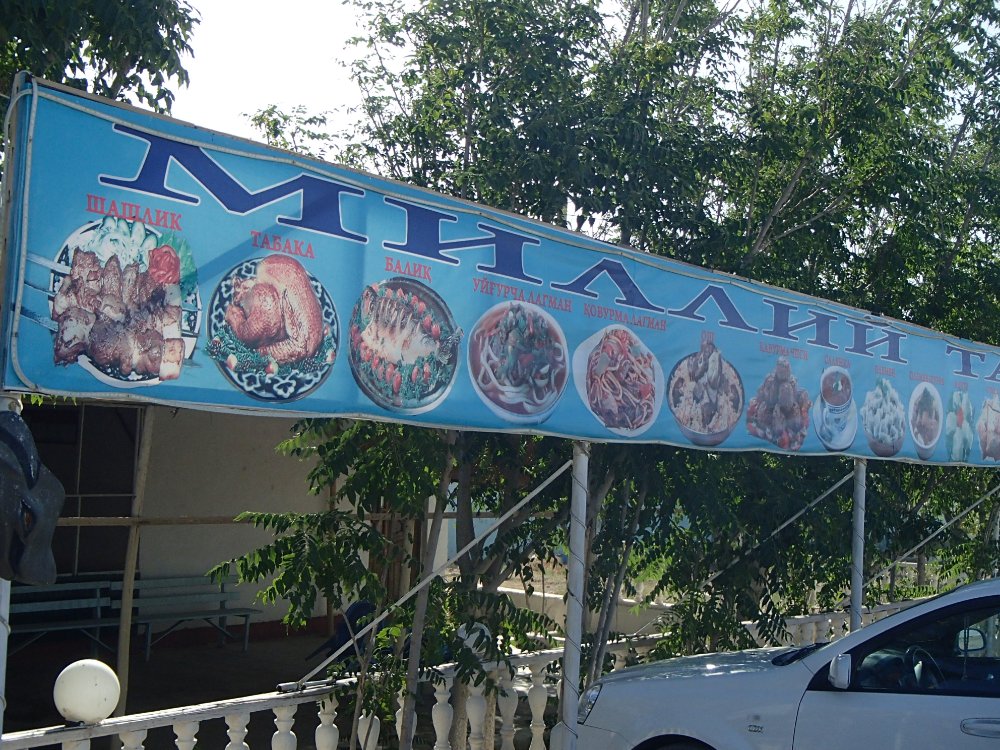
In fact it was this board that told us it was a tea house. All the dishes available were pictured on the menu board. So when we pitched up in need of food and drink it was an easy matter of gesturing to come outside and we’d point to what we wanted to eat. The only snag was practically nothing on the menu board was available.
There were sometimes pasties. These were a hard pastry parcel filled with fairly greasy meat and onions. We think lamb but as with anything that was ‘meat’ it could be anything – well there are lots of horses and camels around… These pasties were cooked in a conical mud/clay oven in which a fire was lit and the pasties were stuck to the side of the oven.

Once cooked, I guess the fire dies down, a lid and an old blanket or two popped on the top to keep them warm and there they stayed until someone ordered one. What can possibly go wrong. A hot pie cabinet! Have I mentioned anything about most cyclists getting tummy trouble – what a wonderful, delicate little euphemism that is…

Then there was ‘sashlik’. Almost always available this one. A skewer of threaded meat and fat barbarqued over hot coals and served with a pile of raw onions. I quite liked the first one that I had. The second and third were good too but meat on a skewer for breakfast, lunch and dinner lost its appeal after a while.
A good teahouse had both of those options available. A really good one had stew! Stew was a piece of meat, a potato and sometimes a carrot floating in a fatty, clear liquid. We had stew a few times. I don’t think either of us ever finished the whole bowl.

One more item on a lot of menus was lagman. This was spaghetti which had boiled for quiet a long time mixed with bits of minced meat and tomato sauce. A portion is then ladled into a pan and it’s fried in a good quantity of oil. A bit like refried spaghetti bolognese . Once we had a fried egg on top…

Then there’s the bread. It seems as if there’s been quite a lot of trouble taken over the bread. But I have to say, in my opinion the effort is utterly wasted. It’s virtually inedible. It’s dry, hard and tasteless. I’m sure cardboard would taste similar. The only interesting thing about the bread is the patterns imprinted by the spiked prodding device. Actually, I’m maybe being a little harsh. The flat frisbee loaf is not the only one available. It is possible to get a ‘loaf’ shaped loaf that doesn’t have the consistency and taste of cardboard. It’s also dry and tasteless.



I read somewhere – “ nobody comes to Uzbekistan for the cuisine “. I agree.
There is another side to the food coin! In Bokhara we stayed in a middle range hotel. Certainly not five star. Not even four or three. A step up from a hostel but a step down from a manned reception with computers and credit card maçhines. A converted merchants house with cool rooms surrounding a courtyard.
What a breakfast we were presented with in the courtyard on that first morning! There were eggs, beautifully presented, pancakes, homemade jams, good bread, cakes, and fruit. All topped off with coffee and juice. It was delicious!

And it was repeated every morning we were there and each day the eggs were cooked differently.
That was by no means the only good breakfast we were served. Here , in Samarkand and in Khiva we ate delicious food in the mornings.
I’ve just tried to think of some memorable evening meals… I asked Chris if she could remember any…

We had a nice pizza in Bokhara…. does that count?
It could be that we’re missing something. We came across this article in an airline magazine:
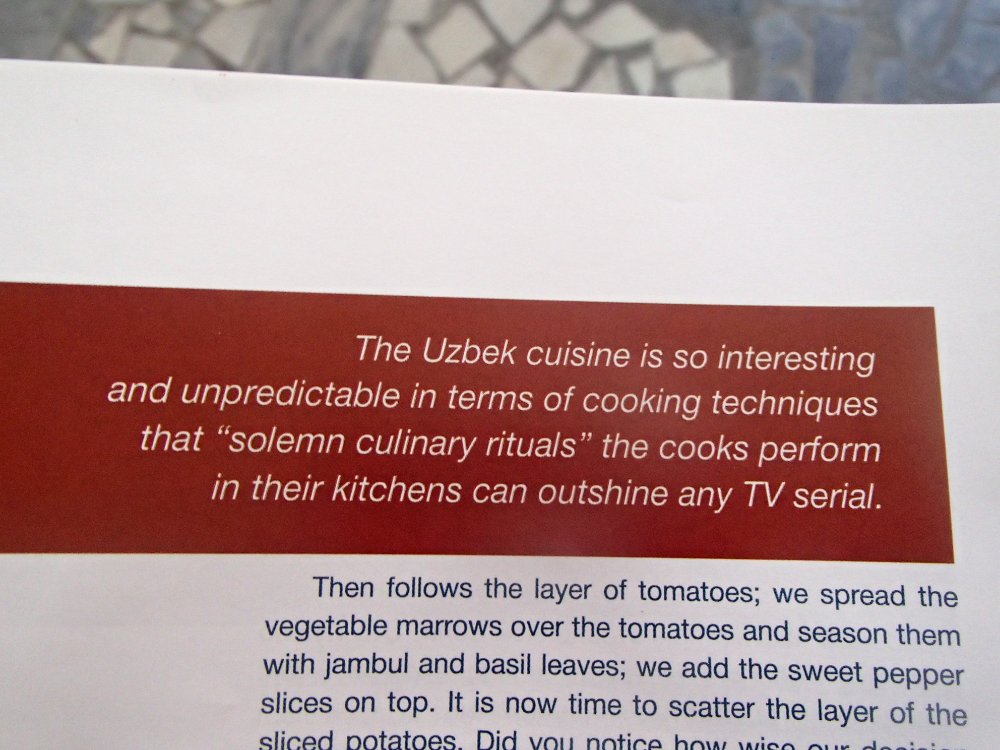 We did see plov being made. It’s a mixture of rice and meat and vegetables. The meat is braised first and then the rice is added a little at a time. A little along the lines of a rissoto (although when I mentioned that to an Italian he looked a bit horrified) l wish I’d waited to taste this one.
We did see plov being made. It’s a mixture of rice and meat and vegetables. The meat is braised first and then the rice is added a little at a time. A little along the lines of a rissoto (although when I mentioned that to an Italian he looked a bit horrified) l wish I’d waited to taste this one.

I must mention the fruit. Stopping under an apricot tree!

The peaches are great too. And there’s nothing like a melon for a refreshing stop.

Have I mentioned the plums and the mulberries?
Supermarkets. Once again a town and country thing. Not much you can’t buy in a city supermarket. In the country areas it was sometimes a struggle to find something to buy. There was always plenty of cola and fanta. Lots of sweets and biscuits. Often not a lot else.

Samarkand market. Everything imaginable piled high. Five hundred years ago, as a major stopping place on the silk road, would it have been very different?
 No, I shouldn’t grumble about the food. I have a feeling there may be even more interesting food to come.
No, I shouldn’t grumble about the food. I have a feeling there may be even more interesting food to come.
Construction.
Next door to one of the teahouses we watched a family making bricks for their house.

The truck was obviously brought in specially. It was supplying the water and the power. The dry clay was shovelled into the hopper, the worm gear compressed the mixture and extruded a brick shaped sausage which was cut to brick length and stacked to dry in the sun.


There were buildings we saw that perhaps wouldn’t meet British regulations – but they worked.
There were others we saw that we’re definitely being built in the local style.

It’s time once again to gird our loins, tighten our chains, pump up our tyres and squish everything back into our panniers. The mountains lie ahead. They’re daunting. Very daunting in fact. We’re going to see rain again. And get cold. We’ve got a fairly gentle introduction. Following a river up its valley then over a 3000mtr pass to Dushambe. Then the real mountains begin. We’re a little bit nervous I think. The Pamirs have always been on the horizon. They are (figuratively and literally) the high point of the journey. Now they’re getting close.

Wonderful exciting tale, very envious but back here we are enjoying an amazing heat wave which goes on and on so sad to report that you missed it. You both look extremely fit and well so the whole challenging experience has obviously been good for you. Hope you eventually find an outstanding gourmet eating establishment. Your reports have certainly changed our perceptions of that part of the world, far more civilised and hospitable than expected. Photos are most interesting and we very much look forward to the next missive, best of good fortune, and safe journey ahead. Best wishes, the Farrells.
Read this one virtually the moment it arrived, I am an addict!
Such a wonderful and enthralling read as always. I laughed out loud many times! How magical to be in Samarkand and the other Silk Road cities.
I can’t promise you that Tajik food is much better but I’ve recently arrived in Kyrgyzstan where it has a little more flavour at last.
Best of luck with the Pamirs. The road to Dushanbe was actually a real highlight for me, such dramatic scenery and deep gorges, though please take care on the horrible tunnel at the top of the pass. Coming out the other side of the tunnel is wonderful though. And I think the Wakhan is well worth it if you relax and take your time and don’t try to rush (we were trying to rush and I think that was our downfall), but I have heard plenty of happy reports from the main M41 road too, with fewer tales of woe – but without going back and doing it also it’s hard to say which is better! I’m sure you’ll enjoy it whatever you do, and how nice to have further company for it also.
I’ll look forward to hearing how you get on.
Best wishes to you both, Frances
” It was only as we were packing up to go that we realised no one else had used the tea house all afternoon. It was only as we cycled down the road and soon came across a very obvious tea house that we wondered if we had been in someone’s home all afternoon. Whoops.”
(I can’t stop laughing about that!)
Fantastic photos! I love the way your faith in humanity keeps being proved right. Impressed, as always, by your courage, fortitude and spirit of adventure!
May the road rise to meet you,
Fiona x
More wonderful tales to tell. I have been trying to plot your route on my Atlas! The Pamirs look very high but so close to China now? Such an amazing travelogue. I do hope it will become a book!!?? Look forward to all your updates. Love Julie xx
Amazing as ever! We love to hear your adventures and are in awe of what you’re doing. Thank you for educating us on a part of the world we know little about. We are thinking of you and hoping all goes well with the mountain challenge. Lots of love, Katy and Brain xx
Again I thoroughly enjoyed reading this article . I was very interested in the food section and I think that you must have cast iron stomachs to cope with what you ate there and the conditions the food was cooked in.
This week the ‘i’ newspaper featured an article from the Lonely Planet on the ten unmissable Asian Adventures to steer tourists well off the beaten track. It featured Uzbekistan and said that it was only last year that the country took great strides in opening up to tourism with visa free and e-visa schemes , new air routes and a new high speed rail line making access to its arsenal of jewelled architecture and ancient cities easier. It also showed a photo of the Samarkand mosque . Normally when reading such articles I have no knowledge of these far away places but this time t I could almost feel the sun and appreciate the country and its people and did not have’ to imagine the mosaic-clad mosques and the Silk Road ‘ because you are there and I have seen it through your detailed blog and photographs. Thanks again.
wonderful!
Look forward to the next instalment.
remember washing hands frequently is a good way to help prevent upset stomachs; which might be hard when water is scarce…..
what is the planned route now?
Take care
Annie
Wonderful news! Wonderful dreams! Take care and may the breezes waft you onwards!
Fantastic account Chris and Pete. I can almost taste the food you describe it so well, although I will pass on some of the delicacies!
Traveling the Silk Road absolutely amazing. Got the Atlas open as I type your adventures are truly amazing. keep safe and warm in the mountains!! Alison x
Thank you for this delightful story, which I have come across by accident a month or so after our (wife and self) tour of these countries. We travelled with a guide and driver, but I loved your descriptions of your lower travels, closer to the country and the road. We could certainly identify with every comment about food. In our case it was more complex because my wife is coeliac. Wonderfully friendly people, and so much history!